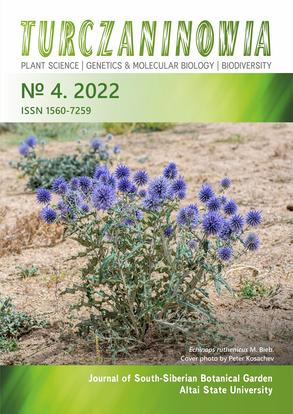Nomenclature and typification of Actinidia kolomikta (Actinidiaceae)
Abstract
The nomenclature and lectotypification of the name Actinidia kolomikta (Maxim.) Maxim. are discussed. The correct authorship and date of publication of its basionym is specified, namely Prunus kolomikta Maxim., 27 XI 1856. The currently known original material of Prunus kolomikta (≡ Actinidia kolomikta) is represented by 5 specimens all stored in the Herbarium of the Komarov Botanical Institute, St. Petersburg, Russia (LE). The specimen LE 01081775 is designated here as the lectotype of Prunus kolomikta, its duplicate LE 01081774 being cited as an isolectotype. The indication of the “holotype” and “isotypes” in the Tropicos database available on the Internet is shown to be erroneous.
Downloads
Metrics
References
Chang C.-S., Kim H., Chang K. S. 2014. Provisional checklist of vascular plants for the Korea Peninsula flora (KPF). Seoul etc.: Seoul Natl. Univ. etc. 660 pp.
Черепанов С. К. Свод дополнений и изменений к «Флоре СССР» (тт. I–XXX). Л.: Наука, 1973. 668 с.
GBIF Secretariat. 2021. Actinidia kolomikta (Maxim. & Rupr.) Maxim. In: GBIF Backbone Taxonomy. Checklist dataset. URL: https://www.gbif.org/ru/species/7270682 (Accessed 18 April 2022). DOI: 10.15468/39omei
IPNI [2021]. International Plant Names Index. Kew: The Royal Botanic Gardens; Harvard University Herbaria; Libraries and Australian National Botanic Gardens. URL: http://www.ipni.org (Accessed 15 March 2022).
Kim Y. Y., Oh B. U. 2013. A taxonomic study of the genus Actinidia in Korea. Korean Journal of Plant Taxonomy 43(4): 285–295. DOI: 10.11110/kjpt.2013.43.4.285
Li H. L. 1952. A taxonomic review of the genus Actinidia. Journal of the Arnold Arboretum. 33(1): 1–61. DOI: 10.5962/p.333934
Li J. Q., Li X. W., Soejarto D. D. 2007. Actinidiaceae. In: Flora of China. Vol. 12. Beijing: Science Press; St. Louis: Missouri Botanical Garden Press. Pp. 334–360.
Li X. W., Li J. Q., Soejarto D. D. 2007. New synonyms in Actinidiaceae from China. Acta Phytotaxonomica Sinica 45(5): 633–660. DOI: 10.1360/aps06061
Lindley J. 1836. A natural system of botany; or, a systematic view of the organisation, natural affinities, and geographical distribution, of the whole vegetable kingdom... 2nd ed. London: Longman, Rees, Orme, Brown, Green, and Longman. xxvi+526 pp. DOI: 10.5962/bhl.title.153128
Maximowicz C. J. 1859. Primitiae florae amurensis. Versuch einer Flora des Amurlandes. Mémoires présentés a l’Académie Impériale des Sciences de St.-Pétersbourg par Divers Savans et lus dans ses assemblées 9: [1]–504; pl. 1–10.
Maximowicz C. J., Regel E. 1857. Vegetations-Skizzen des Amurlandes... nebst Bemerkungen über die von demselben eingesendeten Bäume und Sträucher... Bulletin de la Classe physico-mathématique de l’Académie impériale des sciences de Saint-Pétersbourg 15(14–15): 211–238.
Maximowicz C. J., Ruprecht F. J. 1856. Die ersten botanischen Nachrichten über das Amurland. 1. Abth. Bulletin de la Classe physico-mathématique de l’Académie impériale des sciences de Saint-Pétersbourg 15(8–9): 120–144.
Ohwi J. 1965. Flora of Japan. Washington, Smithsonian Institution. 1067 pp.
Пояркова А. И. Сем. Актинидиевые – Actinidiaceae Van Tiegh. // Флора СССР. Т. 15. М.; Л.: Изд-во Акад. наук СССР, 1949. С. 185–197.
POWO [2022]. Plants of the World Online. Kew: Facilitated by the Royal Botanic Gardens.
URL: http://www.plantsoftheworldonline.org (Accessed 18 April 2022).
Siebold P. F., Zuccarini J. G. 1843. Plantarum, quas in Japonia collegit Dr. Ph. Fr. de Siebold genera nova, notis characteristics delineationibusque illustrata proponunt. Fasc. 1. Abhandlungen der Mathematisch-Physikalischen Classe der Königlich Bayerischen Akademie der Wissenschaften. Munich 3: 717–749; pl. 1–5.
Tropicos [2022]. Missouri Botanical Garden. URL: https://tropicos.org (Accessed 25 March 2022).
Turland N. J., Wiersema J. H., Barrie F. R., Greuter W., Hawksworth D. L., Herendeen P. S., Knapp S., Kusber W.-H., Li D.-Z., Marhold K., May T. W., McNeill J., Monro A. M., Prado J., Price M. J., Smith G. F. (eds.). 2018. International Code of Nomenclature for algae, fungi, and plants (Shenzhen Code) adopted by the Nineteenth International Botanical Congress Shenzhen, China, July 2017. Glashütten (Regnum Vegetabile 159). DOI: 10.12705/Code.2018
Жуковский П. М. Культурные растения и их сородичи. 3-е изд. Л.: Колос, 1971. 751 с.
Turczaninowia is a golden publisher, as we allow self-archiving, but most importantly we are fully transparent about your rights.
Authors may present and discuss their findings ahead of publication: at biological or scientific conferences, on preprint servers, in public databases, and in blogs, wikis, tweets, and other informal communication channels.
Turczaninowia allows authors to deposit manuscripts (currently under review or those for intended submission to Turczaninowia) in non-commercial, pre-print servers such as ArXiv.
Authors who publish with this journal agree to the following terms:
- Authors retain copyright and grant the journal right of first publication with the work simultaneously licensed under a Creative Commons Attribution License that allows others to share the work with an acknowledgement of the work's authorship and initial publication in this journal.
- Authors are able to enter into separate, additional contractual arrangements for the non-exclusive distribution of the journal's published version of the work (e.g., post it to an institutional repository or publish it in a book), with an acknowledgement of its initial publication in this journal.
- Authors are permitted and encouraged to post their work online (e.g., in institutional repositories or on their website) prior to and during the submission process, as it can lead to productive exchanges, as well as earlier and greater citation of published work (See The Effect of Open Access).





